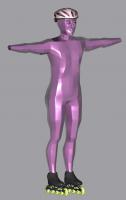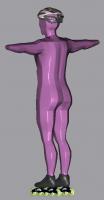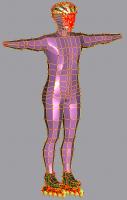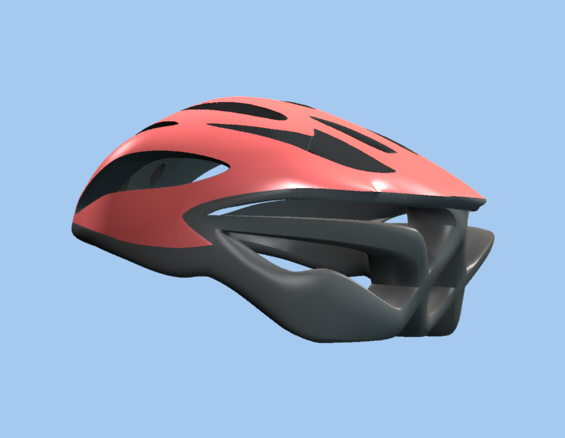
cstanton
*A:M User*-
Posts
179 -
Joined
-
Last visited
Content Type
Profiles
Forums
Events
Everything posted by cstanton
-
Bug Voice: take 3 AVI 3.8MB QT 3.6MB Cory, I re-synced the second scream, added thuds to footsteps (not dog scale), mapped footsteps to left and right channels. Curtis Edit: smoothed out voice a little; corrected channels
-
Rodney's "Making a Tutorial" thread contains ideas from a number of users about the tutorial process and software.
-
I should be able to adjust the time without effecting the pitch for ratios between 75% and 115%. Beyond this range, you'll start to hear artifacts such as echoes, flanging, or drop-outs. Since this isn't exactly a musical voice, some artifacts might be "enhancements" -- We'd have to try it. The footsteps are discreet and can be moved with no problem. Actually, now that I think about it, most of the component samples of the screams have already been time compressed. If the finished version is 200% I can probably re-use the original samples; and I have the EQ parameters I used to squash everything together, so it *shouldn't* be a problem. Curtis
-
Bug Voice -- take 2: QT (3.4MB) AVI (3.8MB) Curtis
-
The voice is a layered hawk and pig squeal combo. The "machine gun fire" is bat echo location; I thought since he didn't have eyes. . . . There's also some snorts, but they don't come through the foot stomps, which are layered bone clacking & multiple hoof stomps which all got muddied by the thump. Curtis
-
The bug gets a voice -- one possibility anyway. AVI bug voice (3.8MB) MOV bug voice (7.1MB) Curtis
-
As David suggested, one of the problems of using a raw screen recording for a tutorial or other purpose is that you can't be sure that your video will fit on someone else's display. These are the steps that I've used to convert a full screen, high res clip to 640x480 or 720x486. This process requires a NLE that accepts the HD 16:9 format on the timeline. In display properties: 1) Set computer screen resolution to 1280x960. In capture application: 2) Set capture region to 1280x960. (I've been using CamStudio 2.0) 3) Capture screen action In display properties: 4) Restore computer screen resolution to your preference (unless it's less than 1280x960) In your non-linear editor 5) Create a new sequence 6) Set new sequence preset format to "Custom Format" 7) Set new sequence frame rate to "30 fps" 8) Set new sequence resolution to 1440x1080 - 16:9 (non-square) 9) Set new sequence interlacing to non interlaced 10) Import footage from capture application to new sequence 11) Insert source into timeline 12) Apply 2D Editor to clip 13) Open 2D editor, expand size function, unlock width and height and expand clip to fill 1440x1080 inlay (probably 150%x114%)--it will look a little squashed. 14) Export sequence using custom size of 640x480, non-interlaced, 30 fps 15) To get out of the resource intensive HD mode, import clip into 640x480 timeline (frame aspect should look right), edit clip, add transitions and VO, etc. Curtis
-
CamStudio 2.0 is a freeware screen recording application--A 2003 PC Mag review. If anyone goes this route, it's important to get Camstudio 2.0 and not 2.1. CamStudio was bought by a commercial developer and CamStudio 2.1 has some features disabled that competed with the commercial product (including Flash output.) CamStudio 2.0 works great, it can output avi or Flash, it can record a voice-over track or, if you have the software, the VO can be recorded separately and combined with the video in an NLE. Curtis
-
That did it, thanks
-
I am unable to play the eyeball creature and mouth creature files. Windows Media Player says certain codecs may be missing. Does anyone have any idea which plugins I need? Thanks, Curtis
-
You might also search for "bicycle chain" Curtis
-
Even if I have the units of measure set to feet, the grid matches the ruler exactly if I set the grid spacing to 1" in 12.0q. You could try setting the units of measure to inches and set the grid spacing to 1". A grid spacing of 0.16' is definitely not going to match every inch on the ruler. (Was this a late night session? I know it's time to go to bed when I to hit "Cancel" instead of "OK" after changing application or system variables and then can't figure out why nothing's changed.) Curtis
-
I uninstalled QT7, re-booted and re-installed from the downloaded installer--I get audio, but still no pterosaur. Any other suggestions? Thanks, Curtis
-
Rodney, I was looking for A:M information about modeling an ear, which led me to Frank Silas' ear tutorial, which led me to a search for A:M Loft, which led me to your "useful links" thread. I'd somehow missed this thread previously--useful indeed, thanks. Still looking for A:M Loft though. All links seem to be broken. Is this application still available? Is it still useful, or have the features been included in more recent versions of A:M? Thanks again, Curtis
-
I have no expertise in these matters, but my first impression is that his right foot is over-balancing the "T" and its left leg is too close to the "T." Trivial issues, but have you tried moving both legs out a little--stage left? Curtis
-
Nice animation and camera moves, but both landings look a little "floaty"--or something. Maybe the jumper should accelerate more noticeably during the descent? Curtis
-
Very minor point: I know loons can't weight much, even so, since the leaf cushion is larger than its base, maybe the base should be tied to the platform in an obvious way. Curtis
-
The original movie displayed properly for me. The clip in post #82 doesn't display in Mozilla or IE. When I download it to play off line QuickTime says the required compressor could not be found. Curtis
-
Commotion is no longer being developed, but it is (was) a great motion graphics program. Has excellent chroma key tools (primatte keyer), motion tracking and image stabilization, B-spline rotoscope tools, and lots of FX stuff. You can still occasionally find V4.1 on eBay for around $30.00. And Matt Silverman's "Commotion Complete" is still available from Toolfarm for $99.00. Great motion graphics tutorials. His table of contents will give you an idea of what's in Commotion. CONTENTS: CHAPTER 01: Interface & Playback CHAPTER 02: Window Menu & File Menu CHAPTER 03: Intro to Paint CHAPTER 04: Cloning CHAPTER 05: Edit Menu CHAPTER 06: Intro to Compositing CHAPTER 07: Intro to Motion Tracking CHAPTER 08: Paint Tracking CHAPTER 09: 2D Animation CHAPTER 10: Stabilization CHAPTER 11: Intro to Rotosplines CHAPTER 12: Tracking Rotosplines CHAPTER 13: Advanced Rotosplining CHAPTER 14: Keying CHAPTER 15: Advanced Matte Creation CHAPTER 16: Integration with After Effects CHAPTER 17: Corner Pin CHAPTER 18: 3D Pan & Tilt Tracking CHAPTER 19: Proxies CHAPTER 20: Write-On Effect CHAPTER 21: New Features in 4.0 CHAPTER 22: Advanced Compositing in 4.0 CHAPTER 23: Advanced Cloning in 4.0 CHAPTER 24: Filter Effects Overview If you're looking for really cheap, it's still good stuff, Curtis edit: Don't know if the Mac version will run on the newer OSs, but the PC version runs on XP Pro, should be good for awhile.
-
Thanks, everyone, for the comments. I'll experiment with the specular values. Also, I found some of the shading that showed up in the spin animation to be distracting. The shading issues didn't show up in the Action Window or Model Window renderings. Changing the lighting and textures and tweaking the splines a little in the abdominal area didn't reduce the shadows or whatever they are in the chor rendering. I made a new version of the helmet using boolean cutters that fits more closely without cutting into his skull. (Though, having trepan surgical tools built into a helmet would probably not meet government safety standards.) I too am interested and a little concerned about how this model is going to animate. I'm torn between finishing the missing features and trying to rig it "as is" to see if it will animate before spending any more time on it. But, Luckbat posted nice images of his hand splines today and David Simmons' eyeball tutorial looks interesting. So, I'll take a crack at the missing features, meanwhile keeping the faith that it will animate OK. Curtis
-
This is my first attempt at a humanoid model. It's intended for a training video. My rationale for creating a crystalline skater was to make the lines and outline as clearly visible as possible (I also thought it would be easier. I don't think it was. I'll have to model a realistic character to know for sure.) He'll eventually have hands, eye balls, and ears (I hope.) I'm posting him as is because I have several specific concerns, but I would appreciate any and all comments and suggestions. 1) I wanted him to be interesting and well defined, but not too distracting or grotesque. What's your initial impression; is he just too weird? 2) I've included a couple of images of the splines. Can you tell from these if he's animatable? (Is that a word? It's not in my dictionary.) 3) The helmet was fine until I put it on his head. I used boolean cutters to create the holes in the white area of the helmet. Unfortunately, they have to project completely through the surface they're cutting. When I place the helmet so it looks like it's sitting snuggly on his head, the cutters cut through his skull. I've been trying to create another version of the helmet by stitching all the holes into the mess, er, mesh, but it's been very time consuming and, after several attempts, I'm not sure it will be successful. Is there a way to specify that you don't want a cutter to cut a particular surface? I haven't had any artistic training or experience and I've never displayed any artistic talent in the past--I'm amazed when my efforts result in something recognizable. So, I'm open to all suggestions. QuickTime Spinning Skater (3.0MB) Windows Media Video Spinning Skater (2.1MB) [attachmentid=10024][attachmentid=10025][attachmentid=10026][attachmentid=10027][attachmentid=10028] Thanks, Curtis
-
connection refused
-
It does look interlaced in places. I've been rendering this stuff as a bitmap sequence. I just found the render setting in the A:M camera and "Field Render" is turned off. I've been compressing it in my video editor because I have more options. I'm compressing it as full frame interpolated, not interlaced. I had been using cut fields to adjust the frame rate to 30fps. I've just re-posted versions made after I changed that to progressive, but it didn't seem to make much difference. Thanks for you observation, I haven't figured it out yet, Curtis
-
Sorry, should be good now.
-
This helmet model, Helmet Fly-by (Windows Media, 851 KB) Helmet Fly-by (QuickTime, 1.12 MB) goes with the inline speed skate: http://www.civicreflections.com/SkateFlyBy_QT.mov (1.2 MB.) I'm having trouble getting a compression setting that doesn't mess up fast motion in QuickTime-I've given up for now. Guess I can't put off much longer the part between the helmet and the skates. Curtis













